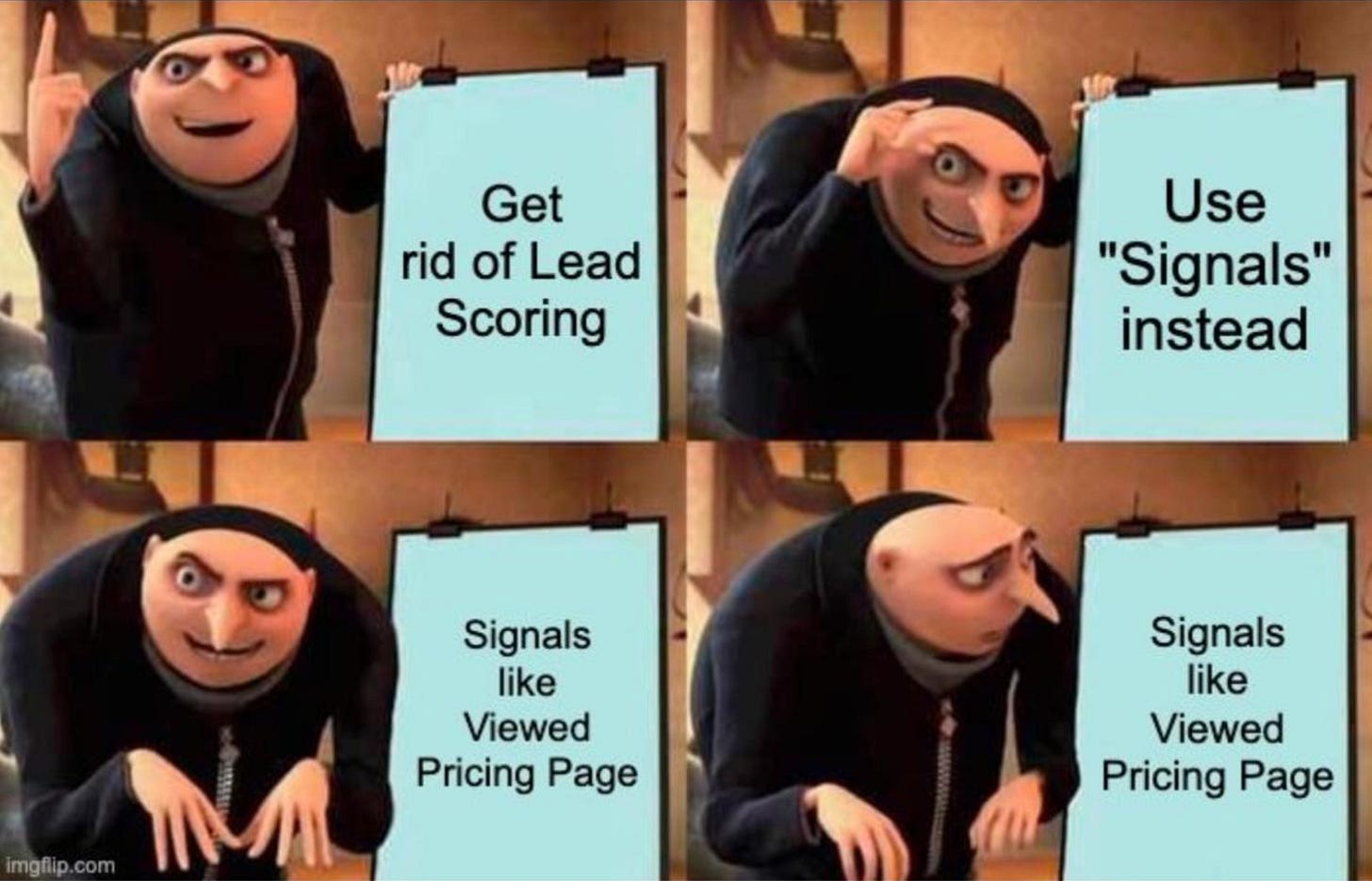👋 Hi, it’s Kaylee Edmondson and welcome to Looped In, my weekly newsletter exploring demand gen and growth frameworks in B2B SaaS. Subscribe to join 1k+ readers who get Looped In delivered to their inbox every Sunday.
In the last 2 weeks I’ve spent an embarrassing amount of time thinking about how we, as an industry, move into signal-based marketing without creating lead scoring 2.0. 😳
If you’re new here, welcome! You’re joining in the midst of me ranting about the new regime that’s starting to shake up ABM. You can catch up on part 1 here and part 2 here.
Adam Schoenfield is also thinking deeply about this evolution and if you don’t already follow him, run and go do that real quick, and then come back. He recently crowdsourced and shared out a market map for the unbundling ABM stack. The TL;DR is that this movement to democratize data and intent is wildly popular right now and there are new players entering the space daily.
But back to avoiding lead scoring 2.0.
For those who might not have had to endure the era of lead scoring 1.0, here’s what you missed. As marketing automation platforms started to evolve and cookie tracking was all the rage, the concept of lead scoring was born.
Lead scoring is a process that, though has evolved over time, was intended to help sales and marketing teams identify which potential customers are most likely to convert into sales:
Early lead scoring: Used explicit criteria like job title, company revenue, and industry to determine a lead's quality
Later lead scoring: Used a variety of first party data points, including behavioral information, to determine a lead's quality
Then came, predictive lead scoring: Using machine learning to calculate a score for open leads based on historical data and most likely outcomes.
However, each evolution still has flaws. And the concept resulted in us mere marketers assigning random, though well-intentioned, points towards actions.
+5 points for visiting the pricing page
-10 points for visiting the careers page
+5 for joining a webinar or downloading a white paper
+10 for opening a promotional email
+10 when a prospect is a middle manager and
+25 if they are a decision-maker in a company
😳 In other words, we created a nightmare really quickly. I spent the early part of my career building these models at every company I joined. I really thought this was the method to the madness at the time. Candidly though I haven’t built, or recommended lead scoring, in the last 5 years. A few of the major drawbacks to this model is oversimplification, not adaptive enough, doesn’t correlate with intent, and these models can become really complex (aka a guessing game) over time.

Fast forward to 2024 and we now have the ability to identify our ICP and build meaningful segmentation against target accounts. As new tech gets spun up, we’re gaining crazy ability to layer signals (1P, 2P, and 3P) to those accounts and in some cases (in the US) to the contact layer. So, where does that leave us?
Well here’s the reality of writing and building in public. I’m working to figure this out for a few of my clients right now (in real time) and I’ve started more actively partnering with some of the most brilliant minds in this space to figure out how we, as an industry, evolve from lead scoring to signal-based marketing at scale (without accidentally creating lead scoring 2.0). It’s easy to imagine a world in which we just layer signals onto the existing lead scoring structure.
But easy just doesn’t feel right, or sustainable. I’m imagining this is solved through an orchestration player that eventually can pipe these signals through a Segment-like tool that overlaps not only with your 1P data but also now the 2P, and 3P data that we have access to.
And then, maybe just maybe, that orchestration player can also find a way to anonymize that data and those signals across their customer base so that customers could have statistically significant insights into the plays that are proven to drive the highest pipeline velocity. 🤔
For now I can confidently say these things:
Expect to hear a lot more about this topic from me in the coming weeks and months.
If you yourself are building a signal-based marketing strategy and have wins/fails, let’s chat!
See ya next week 👋
Kaylee



The way that spam filters work - I swear this is relevant, please stay with me here - is by comparing an incoming email's fingerprint against EVERY other email currently being sent. The patterns shift in real-time, which is why an email that goes to inbox yesterday is in spam today. During COVID, there was a brief uptick in emails that 1) originated from India, and 2) mentioned COVID going to spam because that was the pattern then. It's not the case now. It wasn't the case a week later!
I thought of this now because... what if we could do something similar? Every lead and customer has their own behavioural signals and buying patterns. Let a neural net figure it out. That would remove the need for human-defined signals (idk, maybe companies with pink logos have higher LTVs). It also removes the need for arbitrary scoring - I'm a terribly scored lead because I refuse to attend demos - AND accounts for the full picture so we're not hyperfocusing on one part of the lifecycle.
I think the issue is that signals are being imagined/used for lead scoring type use cases (demand capture for sales) instead of full lifecycle marketing ones. I'd wager vast majority of signals are not immediate buy signals but are acted on as such because the goal is to generate a lead. If you take that mindset away, then they become much more useful. They give clues to the buyer journey and not everyone is in the in-market stage.